You can't pass through Flagstaff, Arizona without visiting the Percival Lowell Observatory on Mars Hill, a National Historic Landmark and home of Pluto!
Planet Pluto? Dwarf Planet Pluto? The observatory that first sought, observed and documented everyone's favorite "Trans-Neptunian Object" has come up with an interesting way to ask people what they think of Pluto's new designation:
Visit and VOTE!
Clever! I generally stay away from the topic of Pluto on social media, because it's like blowing a whistle in the dog pound. One must brace for vehement and sometimes even profanity-laced arguments or pointless debates about a block of ice 7.5 billion kilometers away.
The Lowell Observatory not only side-stepped the opportunity for fighting, but turned it into a money-generating endeavour. We counted through the tops and sides of the cases, and it seems the most cash is inside the "I don't care I just want to support Lowell" box!
Jeanette, me, Richard & Amjad at the entrance pillars
Lowell had many other clever attractions and awesome artifacts from the era when Pluto was discovered, not the least of which was Percival Lowell's very first telescope, original notes and calculations, and early astronomical tools used to seek planets and other celestial bodies, even if the names change over the decades.
We enjoyed an exhibit of space suits through the many NASA program eras, saw a giant Space Shuttle tire (let's just say I could live inside of it), and paid our respects to Percival's nearby Mausoleum.
After dark, we looked through 3 different-sized telescopes in various courtyards and slit domes to see Jupiter, an almost full-Moon, and, through the famed Clark Telescope, a breathtakingly crisp view of Saturn and her brightest moons! I still can't believe I got to look through the CLARK at Saturn!
117-year-old Clark Telescope
Lowell Observatory was established in 1894, placing it among the oldest observatories in the United States, and was designated a National Historic Landmark in 1965. This can be found on my Pillownaut Map of Space-Related NHLs -- perfect for summer roadtrips!





































































